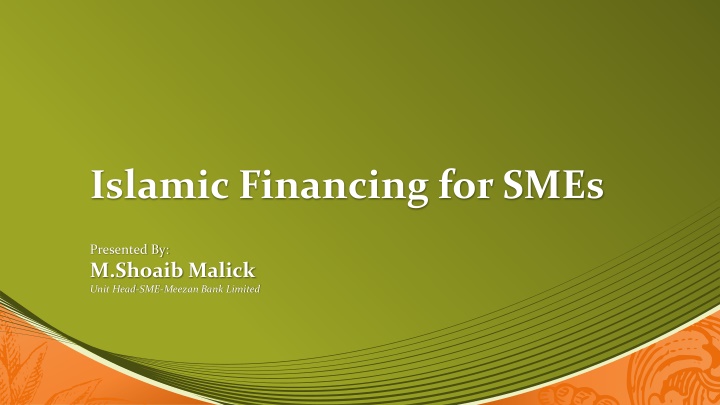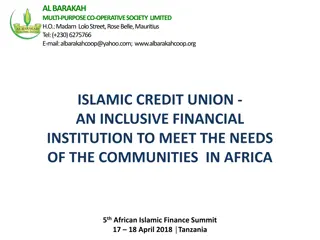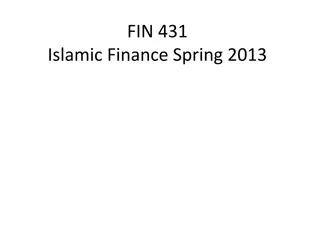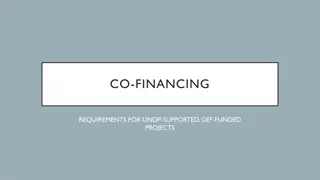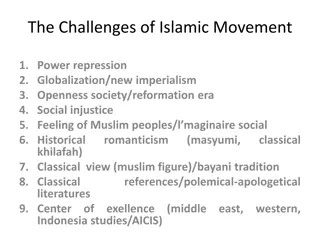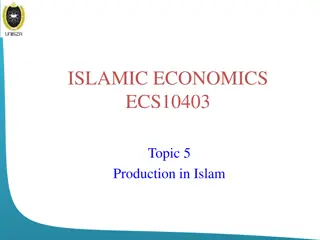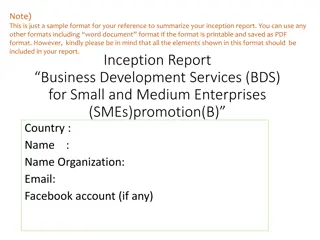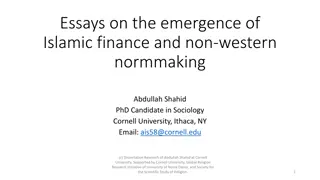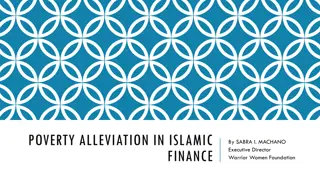Challenges and Opportunities in Islamic Financing for SMEs
Islamic financing for SMEs presents a crucial avenue for addressing the financial needs of small and medium enterprises. The significance of the SME sector, its contribution to the economy, current status of SME financing, reasons for the downfall, and trends in SME financing are discussed. Despite challenges such as declines in financing and growing NPLs, there are opportunities to revive and support SMEs through Islamic modes of financing.
Download Presentation

Please find below an Image/Link to download the presentation.
The content on the website is provided AS IS for your information and personal use only. It may not be sold, licensed, or shared on other websites without obtaining consent from the author.If you encounter any issues during the download, it is possible that the publisher has removed the file from their server.
You are allowed to download the files provided on this website for personal or commercial use, subject to the condition that they are used lawfully. All files are the property of their respective owners.
The content on the website is provided AS IS for your information and personal use only. It may not be sold, licensed, or shared on other websites without obtaining consent from the author.
E N D
Presentation Transcript
Islamic Financing for SMEs Presented By: M.Shoaib Malick Unit Head-SME-Meezan Bank Limited
Islamic Financing for SMEs Introduction to Islamic Banking Significance of SME Sector Difference Between Islamic Banking & Conventional Bank How IB, can address business needs (100%) Comparison of Islamic Mode of Finance and Conventional Islamic Modes of Financing Short Term Modes of Islamic Financing Long Term Modes of Islamic Financing Trade Finance Facilities in Islamic Banking Challenges in SME Financing Conclusion
Significance of SME Sector 1 Total Population 2 Financially Included 3 Financially Excluded 4 Financially Excluded-Major Sector 5 90% of all private enterprises 6 SMEs access to finance from banking sector: Pakistan India Bangladesh 7 SME lending of total credit 8 Surveyed Facts Hard to borrow from banks Not even have a bank account 182Mn 18.2Mn 163.8Mn SME SME 100% 10% 90% 04% 33% 32% 06% 51% 31%
Contribution of SME Sector to Economy Overall Economy SME Sector 100% 30% 25% 80% 35% 75% 60% 40% 20% 0% GDP Exp. Mfgd Goods Mfgd-value added Non-Agri Labor Force
Current Status of SME Financing: SME financing witnessed continues decline by banks/DFIs since 2008. Due to consistent decline in this sector, share of SMEs also reduced from 16% to 6% in overall advances of banks in last 4-5 years. Reasons for downfall: Adverse economic conditions. Law and order situation. Shortage & rising costs of electricity and other utilities.
Reasons for downfall: Growing NPLs. Natural catastrophes also hamper this sector badly in consecutive years of 2010 & 2011 and created wipeout situation for small sized units. Banks also took a risk-averse posture from this sector, due to deteriorating business conditions for SMEs.
5 Years trend of SMEs Status of SME Financing (Rs. In Billions) 4,000.00 3,500.00 3,000.00 2,500.00 2,000.00 1,500.00 1,000.00 500.00 0.00 `Dec-07 437.40 2,700.90 `Dec-08 383.00 3,191.80 `Dec-09 358.90 3,555.30 `Dec-10 334.00 3,489.73 `Dec-11 294.31 3,546.35 `Jun-12 247.86 3,785.87 SME O/s Total O/s
5 Years trend of SMEs SME Borrowers Vs Total Borrowers (In Thousands) 6,000 5,000 4,000 3,000 2,000 1,000 0 `Dec-07 185 4,781 `Dec-08 215 4,544 `Dec-09 214 4,419 `Dec-10 211 3,909 `Dec-11 168 3,733 `Jun-12 148 3,618 SME Borrowers Total Borrowers
5 Years trend of SMEs SME NPLs Vs Total NPLs (Rs. In Billions) 500.00 450.00 400.00 350.00 300.00 250.00 200.00 150.00 100.00 50.00 0.00 `Dec-07 41.30 437.40 9.4% `Dec-08 61.50 383.00 16.1% `Dec-09 79.30 358.90 22.1% `Dec-10 96.50 334.00 28.9% `Dec-11 95.40 294.31 32.4% `Jun-12 96.40 247.86 38.9% Total SME NPLs Total NPLs
SME Financing For Working Capital Key portion of financing is used for working capital in SMEs, which constitutes 76% of total SME lending. However other is followed by Trade Financing & Long term/Fixed Investment. Working Capital Requirement for SMEs 140,000 120,000 100,000 80,000 60,000 40,000 20,000 0 Fixed Working Capital Trade Fiance Investment 12,319 No. of Borrowers Out.Amount (Rs in Billions) 120,426 8,680 173.823 29.336 25.854
SMEs provide a significant portion of jobs world wide SME contribution to formal country employment Median values 70 60 50 40 30 20 10 0 Low Income Middle Income High Income Source. Ayyagari, Beck and Demigirguc/kunt. 2003
GDP Contribution of the SME sector increases, and informality decreases with income 100 SME Sector, 16% 90 SME Sector, 39% SME Sector, 51% 80 70 Informal ,47% 60 Informal , 30% 50 Informal , 13% 40 30 Residual, 37% Residual, 36% Residual, 31% 20 10 0 Low Income Middle Income High Income
Definition of Riba Any increase over and above the price, without due consideration is Riba
Distinguishing Features We find the differences are on three levels: 1. Conceptual & Socio-religious level - not money lenders - cannot deal with interest & non permissible industries 2. Business model & Governing framework - IB actively participates in trade and production process - Governing framework in terms of Shariah Advisor &/or SSB
Distinguishing Features 3. Product Level Implementation - usually asset backed & involve trading/renting of asset & participation on profit & loss basis - Implementation is not just a mere change of paper work and terms but it involves - having the right intention, - the correct sequence of steps and timing of execution 15
PERCEPTION OF ISLAMIC BANKING Islamic Banking Conventional Banking Parties: Limit: Rate: Tenor: Purpose : Bank & Client Rs 10.00 Mn K+2 1 year Parties: Limit : Rate: Tenor : Purpose : Bank & Client Rs 10.00 Mn K+2 1 year To buy Cotton To buy Cotton
PERCEPTION OF ISLAMIC BANKING Islamic Banking Conventional Banking Parties: Limit: Rate: Tenor: Purpose : Bank & Client Rs 10.00 Mn K+2 1 year Parties: Limit : Rate: Tenor : Purpose : Bank & Client Rs 10.00 Mn K+2 1 year To buy Cotton To buy Cotton Goods = OWNERSHIP Services
Islamic Banking Basic Difference between Islamic and Conventional Modes of Finance Conventional Money Client Bank money + money (interest)
Islamic Banking Basic Difference between Islamic and Conventional Modes of Finance Islamic Goods & Services Client Bank money
Income Statement Sales xxx Liability/Deposit Products Cost of Goods Sold Raw Material xxx Murahaba Direct Labor xxx Istisna/Tijarah Over Head xxx Gross Profit xxx Operating Expenses Admin. & Gen. Exp xxx Salaries xxx Istisna/Tijarah Utilities xxx Other xxx Net Profit xxx Deposit Products
Balance Sheet Current Assets: Stocks Receivable Cash in hand Advances & Deposit xxx xxx xxx xxx Murahaba/Import Murahaba/FIM/LC Istisna/Tijarah/Bai-Salam/Usance-Murahaba Deposit Products Murahaba/Istisna/Tijarah/LG Fixed Assets: Plant & Machinery Land & Building Total Assets xxx xxx xxx DM/Ijarah/Murahaba Owner s Equity: Capital xxx Musharka Liabilities: Creditors Financial Liabilities Total Liabilities & Equity xxx xxx Murahaba/LGs/Ijarah/Tijarah
Difference Between Islamic Banking & Conventional Bank Conventional Banks Islamic Banks 1. The functions and operating modes of conventional banks are based on fully manmade principles. 1. The functions and operating modes of Islamic banks are based on the principles of Islamic Shariah. 2. The investor is assured of a predetermined rate of interest. 2. In contrast, it promotes risk sharing between provider of capital (investor) and the user of funds (entrepreneur). 3. It aims at maximizing profit without any restriction. 3. It also aims at maximizing profit but subject to Shariah restrictions. 4. It does not deal with Zakat. 4. In the modern Islamic banking system, it has become one of the service-oriented functions of the Islamic banks to be a Zakat Collection Centre and they also pay out their Zakat. 5. Lending money and getting it back with compounding interest is the fundamental function of the conventional banks. 5. Participation in partnership business is the fundamental function of the Islamic banks. So we have to understand our customer's business very well. 6. It can charge additional money (penalty and compounded interest) in case of defaulters. 6. The Islamic banks have no provision to charge any extra money from the defaulters. Only small amount of compensation and these proceeds is given to charity. Rebates are give for early settlement at the Bank's discretion.
Difference Between Islamic Banking & Conventional Bank Conventional Banks Islamic Banks 7. Very often it results in the bank's own interest becoming prominent. It makes no effort to ensure growth with equity. 7. It gives due importance to the public interest. Its ultimate aim is to ensure growth with equity. 8. For interest-based commercial banks, borrowing from the money market is relatively easier. 8. For the Islamic banks, it must be based on a Shariah approved underlying transaction. 9. Since income from the advances is fixed, it gives little importance to developing expertise in project appraisal and evaluations. 9. Since it shares profit and loss, the Islamic banks pay greater attention to developing project appraisal and evaluations. 10. The conventional banks give greater emphasis on credit- worthiness of the clients. 10. The Islamic banks, on the other hand, give greater emphasis on the viability of the projects. 11. The status of a conventional bank, in relation to its clients, is that of creditor and debtors. 11. The status of Islamic bank in relation to its clients is that of partners, investors and trader, buyer and seller. 12. A conventional bank has to guarantee all its deposits. 12. Islamic bank can only guarantee deposits for deposit account, which is based on the principle of al- wadiah, thus the depositors are guaranteed repayment of their funds, however if the account is based on the mudarabah concept, client have to share in a loss position..
Financing Product Comparison Islamic Vs. Conventional Bank Islamic Product Conventional Products S.# Working Capital Finance a) Murabaha b) Murabaha - Spot c) Istisna - Export & Local d) Meezan Tijarah - Export & Local e) Murabaha FE-25 Export & Import 1 Current Finance / Running Finance 2 Murabaha - Pledge Cash Finance a) Ijarah - Plant & Machinery b) Ijarah - Sale & Lease Back for Plant & Machinery c) Diminishing Musharika - Plant & Machinery d) Diminishing Musharika - Premises / Land for Commercial use e) Diminishing Musharika - Sale & Lease Back (Plant & Machinery; Premises Land & Building) f) Musharaka 3 Demand Finance / Term Finance Meezan Bank Limited
Financing Product Comparison Islamic Vs. Conventional Bank S.# Islamic Product Conventional Products Export Related Facilities: a) Bai Salam against Discrepant Export Sight Bills b) Bai Salam against Export sight contract c) Murabaha against Accepted export Usance Bill (Bank Risk Line) d) Murabaha against Un-accepted export Clean Usance LC e) Murabaha against un-Accepted export Discrepant Bills under Usance LC f) Murabaha against export Usance Contract 1 Finance Against Foreign Bills a) Murabaha against Un-accepted Local Usance LC b) Murabaha against Accepted Local Usance LC (Bank Risk Line) 2 Local Bill Purchases a) Istisna Export b) Islamic Export Refinance Facility (IERF) Part I & II - under Murabaha c) Islamic Export Refinance Facility (IERF) - under Istisna (Local and Export) and Tijara (Local and Export) Finance Against Packing Credit Part - I & II 3
Financing Product Comparison Islamic Vs. Conventional Bank S.# Islamic Product Conventional Products Import Related Facilities: a) Sight LC under MMFA b) Sight LC under Master Agency Agreement (For Ijarah & Diminishing Musharaka) c) Sight LC wihthout MMFA (Exceptional Cases) d) Usance LC without MMFA f) Usance LC under MMFA (Exceptional cases) g) Usance LC under Master Agency Agreement (for Ijarah and Diminishing Musharaka) a) Local LC(Sight) without MMFA b) Local LC (Sight) under MMFA (Exceptional cases) c) Local Usance LC wihtout MMFA d) Local Usance LC under MMFA (Exceptional cases) a) Murabaha - Financing of Imported Merchandise (FIM) Pledge b) Murabaha - Financing of Imported Merchandise (FIM) Spot 1 Import Letter of Credit 2 Inland Letter of Credit Finance Against Imported Merchandise - FIM Finance Against Trust Receipt 3 4 Letter of Guarantee Letter of Guarantee / Shipping Guarantee Letter of Guarantee / Shipping Guarantee/Standby Letter of Credit Meezan Bank Limited 1
Short Term Financing Needs Long Term Financing Needs Raw Material Acquisition/replacement/ expansion of fixed assets, plant & machinery Overheads / Utilities Finished Goods Trade receivable financing Rental financing
Issues & Challenges of SMEs Demand Supply Lack of Collaterals to Meet Bank s Requirements Shortage of Marketing Skills-(Bank Side) Informal Organizational Structures SMEs perceived as high risk borrowers Informal Accounts & Management System Corporate Finance Mindset Lack of Credit & Collateral History Lack of Infrastructure for SME Business Low Level of Financial Literacy High Lending Costs Reluctance on part of SMEs Absence of SME R&D Centers in Banks External Shocks
Plain Murabaha Advance Payment Murabaha Suppliers Credit Murabaha SLC under MMFA Tijarah Istisna Diminishing Musharaka Ijarah Bai Salam
Plain Murabaha Murabaha Agreement Purchase of Goods by Agent Agency Agreement Order Form Offer & Acceptance (Murabaha Contract) Intimation of possession of goods by the agent (Declaration) Payment of Murabaha Price Payment of Purchase Price* *Payment of purchase price is either direct payment to supplier or through customer account button_65201006_std.gif For Detail
Advance Payment Murabaha Murabaha Agreement Agency Agreement Payment of Purchase Price* Order Form Offer & Acceptance (Murabaha Contract) Intimation of possession of goods by the agent (Declaration) Payment of Murabaha Price Purchase of Goods by Agent *Payment of purchase price is either direct payment to supplier or through customer account
Credit Murabaha Murabaha Agreement Purchase of Goods by Agent Agency Agreement Order Form Offer & Acceptance (Murabaha Contract) Intimation of possession of goods by the agent (Declaration) Payment of Murabaha Price Payment of Purchase Price* *Payment of purchase price is either direct payment to supplier or through customer account
SLC under MMFA Murabaha Agreement Order Form & LC Application Establishment of LC Receipt of Import Documents Agency Agreement Offer & Acceptance (Murabaha Contract) Intimation of possession of goods by the agent (Declaration) Retirement of LC Through Murabaha Payment of Murabaha Price
Tijarah Payment of Tijarah Price upon Acceptance Delivery of Goods & Acceptance of Delivery by bank Master Tijarah Agreement Agency Agreement Written Offer Offer & Acceptance (Murabaha Contract) Intimation of possession of goods by the agent (Declaration) Retirement of LC Through Murabaha Payment of Murabaha Price button_65201006_std.gif For Detail
